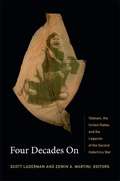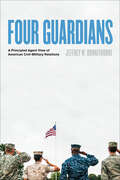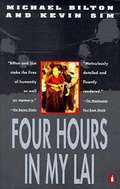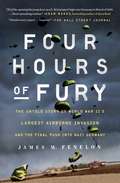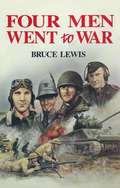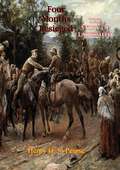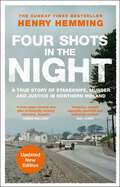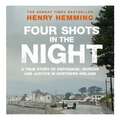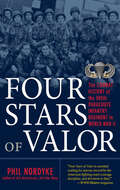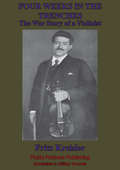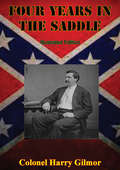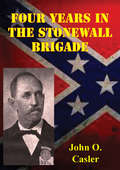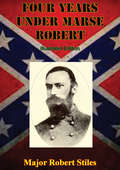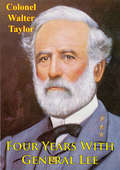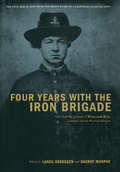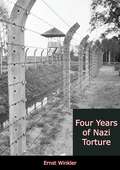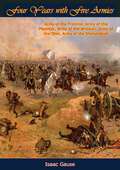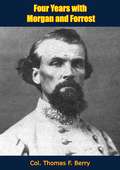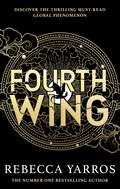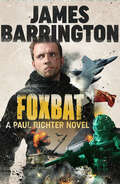- Table View
- List View
Four Decades On: Vietnam, the United States, and the Legacies of the Second Indochina War
by Scott Laderman Martini Edwin A.In Four Decades On, historians, anthropologists, and literary critics examine the legacies of the Second Indochina War, or what most Americans call the Vietnam War, nearly forty years after the United States finally left Vietnam. They address matters such as the daunting tasks facing the Vietnamese at the war's end--including rebuilding a nation and consolidating a socialist revolution while fending off China and the Khmer Rouge--and "the Vietnam syndrome," the cynical, frustrated, and pessimistic sense that colored America's views of the rest of the world after its humiliating defeat in Vietnam. The contributors provide unexpected perspectives on Agent Orange, the POW/MIA controversies, the commercial trade relationship between the United States and Vietnam, and representations of the war and its aftermath produced by artists, particularly writers. They show how the war has continued to affect not only international relations but also the everyday lives of millions of people around the world. Most of the contributors take up matters in the United States, Vietnam, or both nations, while several utilize transnational analytic frameworks, recognizing that the war's legacies shape and are shaped by dynamics that transcend the two countries. Contributors. Alex Bloom, Diane Niblack Fox, H. Bruce Franklin, Walter Hixson, Heonik Kwon, Scott Laderman, Mariam B. Lam, Ngo Vinh Long, Edwin A. Martini, Viet Thanh Nguyen, Christina Schwenkel, Charles Waugh
Four Guardians: A Principled Agent View of American Civil-Military Relations
by Jeffrey W. DonnithorneExploring the profound differences between what the military services believe—and how they uniquely serve the nation.When the US military confronts pressing security challenges, the Army, Navy, Air Force, and Marine Corps often react differently as they advise and execute civilian defense policies. Conventional wisdom holds that these dynamics tend to reflect a competition for prestige, influence, and dollars. Such interservice rivalries, however, are only a fraction of the real story. In Four Guardians, Jeffrey W. Donnithorne argues that the services act instead as principled agents, interpreting policies in ways that reflect their unique cultures and patterns of belief. Chapter-length portraits of each service highlight the influence of operational environment ("nature") and political history ("nurture") in shaping each service's cultural worldview. The book also offers two important case studies of civil-military policymaking: one, the little-known story of the creation of the Rapid Deployment Joint Task Force in the early 1980s; the other, the four-year political battle that led to the passage of the Goldwater-Nichols Act in 1986. Donnithorne uses these cases to demonstrate the principled agent framework in action while amply revealing the four services as distinctly different political actors. Combining crisp insight and empirical depth with engaging military history, Four Guardians provides practical utility for civil-military scholars, national security practitioners, and interested citizens alike. This timely work brings a new appreciation for the American military, the complex dynamics of civilian control, and the principled ways in which the four guardian services defend their nation.
Four Hours in My Lai
by Kevin Sim Michael BiltonUncovering the secrets behind the 1968 My Lai massacre in Vietnam, this is "a brutal, cautionary tale that serves as a painful reminder of the worst that can happen in war. "--Chicago Tribune.
Four Hours of Fury: The Untold Story of World War II's Largest Airborne Invasion and the Final Push into Nazi Germany
by James M. Fenelon&“Compellingly chronicles one of the least studied great episodes of World War II with power and authority…A riveting read&” (Donald L. Miller, New York Times bestselling author of Masters of the Air) about World War II&’s largest airborne operation—one that dropped 17,000 Allied paratroopers deep into the heart of Nazi Germany.On the morning of March 24, 1945, more than two thousand Allied aircraft droned through a cloudless sky toward Germany. Escorted by swarms of darting fighters, the armada of transport planes carried 17,000 troops to be dropped, via parachute and glider, on the far banks of the Rhine River. Four hours later, after what was the war&’s largest airdrop, all major objectives had been seized. The invasion smashed Germany&’s last line of defense and gutted Hitler&’s war machine; the war in Europe ended less than two months later. Four Hours of Fury follows the 17th Airborne Division as they prepare for Operation Varsity, a campaign that would rival Normandy in scale and become one of the most successful and important of the war. Even as the Third Reich began to implode, it was vital for Allied troops to have direct access into Germany to guarantee victory—the 17th Airborne secured that bridgehead over the River Rhine. And yet their story has until now been relegated to history&’s footnotes. In this viscerally exciting account, paratrooper-turned-historian James Fenelon &“details every aspect of the American 17th Airborne Division&’s role in Operation Varsity...inspired&” (The Wall Street Journal). Reminiscent of A Bridge Too Far and Masters of the Air, Four Hours of Fury does for the 17th Airborne what Band of Brothers did for the 101st. It is a captivating, action-packed tale of heroism and triumph spotlighting one of World War II&’s most under-chronicled and dangerous operations.
Four Men Went to War
by Bruce LewisThis book tells of the adventures of four men of different nationalities who found themselves caught up in the maelstrom of the Second World War.
Four Months Besieged: Being Unpublished Letters from H. H. S. Pearse, the "Daily News" Special Correspondent [Illustrated Edition]
by Henry H. S. PearseRichly illustrated with plans, maps and drawings throughout.The siege of Ladysmith will long remain in the memories of the age. The annals of war furnish the record of many fierce struggles, in which men and women have undergone sufferings more terrible and possibly shown a devotion rising to sublimer heights. But the Boer War of 1899-1900 will mark an epoch, and throughout its opening stage of four months the minds of men, and the hopes and fears of the whole British race, centred upon the little town in mid-Natal where Sir George White with his army maintained a valiant resistance against a strenuous and determined foe without, and disease and hunger and death within, until, to use his own words, that slow-moving giant John Bull should pass from his slumber and bestir himself to take back his own. For that reason alone the story of Ladysmith will remain memorable. But it is a story which is brilliant in brave deeds, which tells of danger boldly faced, of noble self-sacrifice to duty, in calm endurance of many and growing evils a story worth the telling. Yet so far it has been told only in the necessarily disjointed telegrams and letters of the press correspondents in the town. Native runners who were captured and otherwise went astray, and the ruthless pencil of the censor, were accountable for many gaps. Two or three of the letters contained in the following pages escaped these perils, and were published in the columns of the Daily News. The rest of the book now appears for the first time. The volume consists of pages from the letters and diaries of Mr. Henry H. S. Pearse, the Special Correspondent of the Daily News. Mr. Pearse was in Natal when the war broke out, and he was in Ladysmith during the whole of the siege. He was fortunate enough to enjoy good health throughout, and though he had some narrow escapes he was never hit. His letters contain a complete story of the siege.
Four Relentless Days: Four Relentless Days (mission: Six) / In The Lawman's Protection (omega Sector: Under Siege) (Mission: Six)
by Elle JamesCaught in a web of dangerA SEAL will risk everythingSexy SEAL “Harm” Harmon Payne isn’t looking for love…or trouble. Until he encounters the prettiest creature on the savanna, Talia Montclair. The safari resort owner has been plagued by a series of threatening incidents. This kind of trouble Harm can handle. But when Talia mysteriously disappears, Harm’s SEAL instincts kick in. His new mission: find the only woman he has ever loved.Mission: Six
Four Shots in the Night: A True Story of Stakeknife, Murder and Justice in Northern Ireland
by Henry Hemming'A truly page-turning, compulsive and also profoundly moving narrative. Superb.' JAMES HOLLAND'Gripping, urgent, superbly reported and brilliantly written' DAN JONES'A gripping and pacey book that reads like a thriller. I found it shocking in a world where I didn't think I could be shocked any more. Henry Hemming wears his extensive research very lightly and manages to shape a great narrative from a complex and dark episode from our recent history. An important and skilfully crafted book.' JOHN O'FARRELLHOW THE DEATH OF A SPY IN THE IRA LED TO ONE OF THE BIGGEST MURDER INVESTIGATIONS IN BRITISH HISTORY. On 26th May 1986, the body of an undercover British agent was found by the side of a muddy lane, with a rope tied around its wrists and tape over each eye. Years later, it was reported that this murder might have been carried out by another undercover British agent, known as 'Stakeknife'. In 2016, a detective began to investigate this case, and would soon find himself running the largest murder investigation in British history.In a compulsive blend of investigative journalism and true crime thriller, Henry Hemming exposes the parallel worlds of the IRA and British intelligence through the lives of those inextricably bound up in both. He reveals the bravery of those who were crucial in ending the Troubles in Northern Ireland, the bloodiest and longest-running conflict in recent British history, and the determination of one detective in his dogged search for justice and the truth.'a compelling story' - The Times'[a] gripping and consistently surprising true-life thriller' - Observer
Four Shots in the Night: A True Story of Stakeknife, Murder and Justice in Northern Ireland
by Henry Hemming'A truly page-turning, compulsive and also profoundly moving narrative. Superb.' JAMES HOLLAND'Gripping, urgent, superbly reported and brilliantly written' DAN JONES'A gripping and pacey book that reads like a thriller. I found it shocking in a world where I didn't think I could be shocked any more. Henry Hemming wears his extensive research very lightly and manages to shape a great narrative from a complex and dark episode from our recent history. An important and skilfully crafted book.' JOHN O'FARRELLHOW THE DEATH OF A SPY IN THE IRA LED TO ONE OF THE BIGGEST MURDER INVESTIGATIONS IN BRITISH HISTORY. On 26th May 1986, the body of an undercover British agent was found by the side of a muddy lane, with a rope tied around its wrists and tape over each eye. Years later, it was reported that this murder might have been carried out by another undercover British agent, known as 'Stakeknife'. In 2016, a detective began to investigate this case, and would soon find himself running the largest murder investigation in British history.In a compulsive blend of investigative journalism and true crime thriller, Henry Hemming exposes the parallel worlds of the IRA and British intelligence through the lives of those inextricably bound up in both. He reveals the bravery of those who were crucial in ending the Troubles in Northern Ireland, the bloodiest and longest-running conflict in recent British history, and the determination of one detective in his dogged search for justice and the truth.'a compelling story' - The Times'[a] gripping and consistently surprising true-life thriller' - Observer
Four Stars Of Hell
by Laurence CritchellThe wartime exploits of the 501st Parachute Infantry Regiment are told here in the most vivid and appropriate way; by one of the men who experienced their battles firsthand - Captain Laurence Critchell. The author fought with the men of the Screaming Eagles from the tough training at camp Toccoa, Georgia to their hellish night drop on D-Day and all the way to the capture of Hitler's mountain retreat at Berchtesgaden. During 1944-1945 the author and his comrades soldiers would be involved in some of the heaviest and bloodiest fighting in Europe, during the Operation Market Garden at Njimegen and the Battle of the Bulge at Bastogne. A gripping read of the Second World War as told by a decorated combat veteran."It is fitting that the story of the 501st Parachute Regiment of the famed 101st Airborne Division should be told by a parachute captain."--The New York Times"A personalized record, told in terms of the men of all ranks, of how they trained and fought and died... the story has an authentic ring."--U.S. Quarterly"The greatest airborne operation of this or any other war." --Lewis H. Brereton, Former Lt. General, First Allied Airborne Army, World War II
Four Stars of Valor: The Combat History of the 505th Parachute Infantry Regiment in World War II
by Phil NordykeHailing from the big cities and small towns of America, these young men came together to serve their country and the greater good. They were the 505th Parachute Infantry Regiment of the 82nd Airborne Division (the All Americans). Phil Nordyke, their official historian, draws on interviews with surviving veterans and oral history recordings as well as official archives and unpublished written accounts from more than three hundred veterans of the 505th PIR and their supporting units. This is history as it was lived by the men of the 505th, from their prewar coming of age in the regiment, through the end of World War II, when they marched in the Victory Parade up Fifth Avenue in New York, to the postwar legacy of having been part of an elite parachute regiment with a record unsurpassed in the annals of combat.
Four Weeks In The Trenches; The War Story Of A Violinist [Illustrated Edition]
by Fritz KreislerFriedrich "Fritz" Kreisler was an Austrian-American violinist and composer of great renown, often regarded as one of the finest violinists of all time. He was, however, for a brief time an officer of the Austrian army during the First World War; but unlike the voluminous literature of Gallipoli and the Western Front in English, his memoirs of the fighting on the Eastern Front provide a rare insight seldom seen. Although clearly not a full record of the time that he spent in the Austrian service, before being honourably discharged after being wounded, the events that he chronicled are of considerable detail, artistic merit and lasting interest.
Four Weeks in the Trenches: The War Story of a Violinist
by Fritz KreislerFour weeks in the Trenches is the first-hand record of the experiences of Fritz Kreisler, one of the most renowned violinists of the twentieth century, during his service in the Austrian Army in World War I.
Four Years In The Saddle [Illustrated Edition]
by Colonel Harry GilmorIncludes Civil War Map and Illustrations Pack - 224 battle plans, campaign maps and detailed analyses of actions spanning the entire period of hostilities.The brutal occupation of Baltimore in 1861 by the Federal troops under Benjamin "Beast" Butler, would be the final straw for many Confederate leaning Marylanders. One such was Harry Gilmor, imprisoned for his political beliefs and his service in the Baltimore County Horse Guards, he was determined to join the Southern forces. As soon as he was released from prison he travelled as fast as possible to join the troops under Colonel Turner Ashby; by March 1862 he was commissioned as a captain of the Twelfth Virginia Cavalry. He set to his task with a passion earning much glory fighting under Jackson in the Valley campaign, even being entrusted with special missions by the great general himself. His military star was on the rise and he began to gain a sterling reputation as a cavalry commander often employed in scouting, raids and ambushes. He was in action at the Battle of Brandy Station, in the Shenandoah Valley and led the famous "Raid Round Baltimore" in 1864. Despite all his cunning and daring the tide of war turned against him and his Confederate comrades and he was captured in February 1865 in Hardy County. As a successful Confederate raider the Federal press had heaped calumnies upon him and his men, so after the war he wrote these memoirs to set the record straight.A dashing read of a famous Confederate cavalry officer.
Four Years In The Stonewall Brigade [Illustrated Edition]
by John O. CaslerIncludes more than 30 illustrations of the author's unit and the actions it engaged in."The classic tale of battle, roguery, and capture from the Army of Northern Virginia. From his looting of farmhouses during the Gettysburg campaign and robbing of fallen Union soldiers as opportunity allowed to his five arrests for infractions of military discipline and numerous unapproved leaves, John O. Casler's actions during the Civil War made him as much a rogue as a Rebel. Though he was no model soldier, his forthright confessions of his service years in the Army of Northern Virginia stand among the most sought after and cited accounts by a Confederate soldier. First published in 1893 and significantly revised and expanded in 1906, Casler's Four Years in the Stonewall Brigade recounts the truths of camp life, marches, and combat. Moreover, Casler's recollections provide an unapologetic view of the effects of the harsh life in Stonewall's ranks on an average foot soldier and his fellows. A native of Gainesboro, Virginia, with an inherent wanderlust and thirst for adventure, Casler enlisted in June 1861 in what became Company A, 33rd Virginia Infantry, and participated in major campaigns throughout the conflict, including Chancellorsville and Gettysburg. Captured in February 1865, he spent the final months of the war as a prisoner at Fort McHenry, Maryland. His postwar narrative recalls the realities of warfare for the private soldier, the moral ambiguities of thievery and survival at the front, and the deliberate cruelties of capture and imprisonment with the vivid detail, straightforward candor, and irreverent flair for storytelling that have earned "Four Years in the Stonewall Brigade" its place in the first rank of primary literature of the Confederacy."-Print ed.
Four Years Under Marse Robert [Illustrated Edition]
by Major Robert StilesIncludes Civil War Map and Illustrations Pack - 224 battle plans, campaign maps and detailed analyses of actions spanning the entire period of hostilities."Marse Robert" is one of the endearing nicknames by which General Robert E. Lee was called by his men. This book is the account of Robert Stiles' experience as a soldier during the Civil War. He traces his own story, giving personal significance to the battles fought and the time he spent under General Lee's command.Robert Stiles tells firsthand what a Confederate soldier experienced as he marched on and fought through great struggles and deprivation. He takes readers on the difficult journey through the Civil War battle by battle, while providing the personal analysis of an actual participant.
Four Years With General Lee [Illustrated Edition]
by Colonel W H TaylorIncludes Civil War Map and Illustrations Pack - 224 battle plans, campaign maps and detailed analyses of actions spanning the entire period of hostilities."...it offers a sure, quick, eyewitness assessment of all Lee's campaigns." --Southern PartisanColonel Taylor was the Adjutant-General of the Army of Northern Virginia, and Lee's right-hand man at Headquarters. Most of the orders and dispatches went out in Taylor's handwriting, and he was uniquely positioned to observe Lee's thinking and generalship close-up.In addition, Taylor was responsible for the "returns" (manpower statistics), and so is able to correlate the accounts of campaigns and battles with the actual strength of Confederate forces. The conclusion is inescapable: few military commanders have done more, with less, than Lee, and fewer still can have emerged with his reputation as a human being.The book concludes with the Address on the Character of General R.E. Lee, by Captain John Hampden Chamberlayne, delivered in 1876, which is a fine analysis on the career and character of the great General.
Four Years With the Iron Brigade: The Civil War Journals of William R. Ray, Co. F., Seventh Wisconsin Infantry
by Lance Herdegen Sherry MurphyBased on an major recent discovery-the Civil War as seen from the front ranks of a legendary fighting unit
Four Years of Nazi Torture
by Ernst WinklerErnst Winkler, a soldier and pilot under the Weimar Republic, resigned when Hitler came into power and accepted a position as one of the leaders of the Catholic Youth Movement. In 1934, he was arrested by the Gestapo when he refused army service because, as a devout Catholic, he opposed the Nazis, and subjected to a series of concentration camps and all manner of physical brutalities.On his return to his family in 1938, Winkler found them divided, his brothers Nazified. He left home and became part of the underground movement, broadcasting from mobile Freedom stations. Eventually, he was forced to escape to Switzerland, then over to France, and from France into Spain; his wife followed, and they reached their final destination by steamer: the United States.Four Years of Nazi Torture, which was first published during World War II in 1942, is author Ernst Winkler’s gruelling personal account of punishment without crime under the Nazi regime.“A terrible story—simply told”—Kirkus Reviews
Four Years with Five Armies: Army of the Frontier, Army of the Potomac, Army of the Missouri, Army of the Ohio, Army of the Shenandoah
by Isaac GauseIsaac Gause, served in Company E, 2nd Ohio Volunteer Cavalry Regiment, during the Civil War reaching the rank of sergeant. 2nd Ohio Volunteer Cavalry Regiment fought in the Knoxville Campaign, Battle of the Wilderness, Sheridan's Shenandoah Valley Campaign and finally the Appomattox Campaign. Gause served with distinction and went from a naïve teenage to a toughened NCO who would be awarded the Medal of Honor for capturing the colors of 8th South Carolina Infantry near Berryville.A vivid and exciting cavalry memoir from the Civil War.
Four Years with Morgan and Forrest [Illustrated Edition]
by Col. Thomas F. BerryIncludes Civil War Map and Illustrations Pack - 224 battle plans, campaign maps and detailed analyses of actions spanning the entire period of hostilities.First published in 1914, these are the recollections of Colonel Thomas Berry, taken from his diary kept during service in the Confederate Army when he served under Confederate General Nathan Bedford Forrest and General John Hunt Morgan during the Civil War.Berry’s narrative includes Morgan’s invasion into Indiana, Chickamauga, Rock Island prison, serving with General Joe Shelby in Mexico, escaping from the Yankees no less than thirteen times, and much more.A fascinating read.
Fourth Down (Game On #4)
by Desiree HoltThe stakes are high even off the field in a scorching romance from the USA Today bestselling author of Pass Interference and Line of Scrimmage. When her relationship goes up in flames, Holly Funchess jumps straight back into the heat—by becoming a firefighter. Running as far away from her past as she can, Holly trains hard and lands a job with a small San Diego firehouse. With everything to prove, she has no problem putting her love life on the back burner. But where there&’s smoke . . . A former football player with a string of failed relationships behind him, Chase DeMarco has put his all into his Coast Guard career and the youth football team he coaches. He&’s not about to let anyone distract him—especially Holly, the woman at his gym who seems to relish getting under his skin. But when their skirmishes turn into full-contact workouts—and they face off against the dangers of their jobs—Chase and Holly must choose between letting the clock run down or playing to win… Praise for Desiree Holt and her fan-favorite novels &“Readers can&’t help but root for them to fall in love.&”—RT Book Reviews &“Her novels are about the story: the characters, their motivations, their flaws and back stories and always about human nature. They are also about mature love and respect and very steamy sex.&”—Austin American-Statesman &“I have read many other books by Desiree Holt and have enjoyed every one of them. Just keep them coming.&”—Fresh Fiction
Fourth Wing: DISCOVER THE GLOBAL PHENOMENON THAT EVERYONE CAN'T STOP TALKING ABOUT! (The Empyrean #1)
by Rebecca YarrosDON'T BE THE LAST TO DISCOVER THE SERIES THAT EVERYONE CAN'T STOP TALKING ABOUT:'Pure escapism - think Hunger Games meets Fifty Shades' The Sun'We weren't expecting to become obsessed . . . but we very much are and we're not alone' Sunday Times Style'This book contains an addictive, drug like essence that will make you relinquish all responsibility' Glamour 'Yarros had me hooked from the first chapter' Mail on Sunday__________________________________________FRIENDS. ENEMIES. LOVERS . . .EVERYONE HAS AN AGENDAViolet Sorrengail expected to live a quiet life surrounded by books, until she was forced onto the world's deadliest training ground. Now she must fight to join the army's elite: dragon riders. But dragons don't choose fragile riders, they incinerate them, and when your body breaks as easily as Violet's does - death is only a heartbeat away.EVERY NIGHT COULD BE YOUR LASTMany cadets would kill Violet to better their own chances of success; the rest would kill her just because of her last name . . . including the ruthless Xaden Riorson, her family's greatest enemy. With the odds stacked against her, Violet must use every edge her wits can give her just to see the next sunrise, because once you enter Basgiath War College, there are only two ways out:GRADUATE OR DIE__________________________________________ OVER ONE MILLION READERS HAVE ALREADY GIVEN FOURTH WING FIVE STARS. ARE YOU READY TO ENTER THE WORLD OF BASGIATH WAR COLLEGE? 'The new publishing sensation' Daily Mail'I couldn't put it down!' Millie Bobby Brown'If I can convince you to read one book I recommend it would be this one''I didn't sleep, I didn't eat, and when I finished, I had the overwhelming urge to just start it all over again''This book is probably the best fantasy book I have ever read''FIVE. FREAKING. STARS. There is no universe where I could give this book any less of a rating''There are some stories you read and enjoy but every so often you come across one that just obliterates everything and takes over your entire being within a few pages and becomes your world and personality. Well, this is the one''The world building in this was phenomenal. I lived, breathed and became a part of the college''You know when you finish a book, and it leaves an ache in your chest because it was so good, and now it's over? That's exactly how I feel after finishing Fourth Wing'OTHER BOOKS IN THE EMPYREAN SERIES:- FOURTH WING- IRON FLAME- ONYX STORM *Rebecca Yarros's Fourth Wing paperback was an instant number-one bestseller in the first week of April 2024.
Fox Girl
by Nora Okja KellerNora Okja Keller, the acclaimed author of Comfort Woman, tells the shocking story of a group of young people abandoned after the Korean War. At the center of the tale are two teenage girls—Hyun Jin and Sookie, a teenage prostitute kept by an American soldier—who form a makeshift family with Lobetto, a lost boy who scrapes together a living running errands and pimping for neighborhood girls. Both horrifying and moving, Fox Girl at once reveals another layer of war's human detritus and the fierce love between a mother and daughter. .
Foxbat (Agent Paul Richter Thriller)
by James BarringtonStop the nuclear strike – at all costs…1976: A Russian pilot defects to Japan in a MiG-25 Foxbat interceptor, but is prematurely captured by the Americans. Before the aircraft is handed back to the Russians, it is reduced to a pile of components and then rebuilt. Despite the wealth of intelligence the Americans glean, however, they fail to realise its true purpose…The present day: American satellites have detected unusual activity at several Algerian air bases. At Aïn Oussera, a large hangar has been cordoned off and armed guards are posted outside. Western intelligence agencies suspect that Algeria might be launching an attack on Libya or Morocco. But they also have a greater concern: that these new weapons systems could be targeted by a rogue nuclear state. With global security in the balance, the only way to find the true threat is to get someone inside.Paul Richter is this ‘deniable asset’, called into action once more in a furiously exciting thriller, perfect for fans of Tom Clancy, Robert Ludlum or Mark Greaney.
